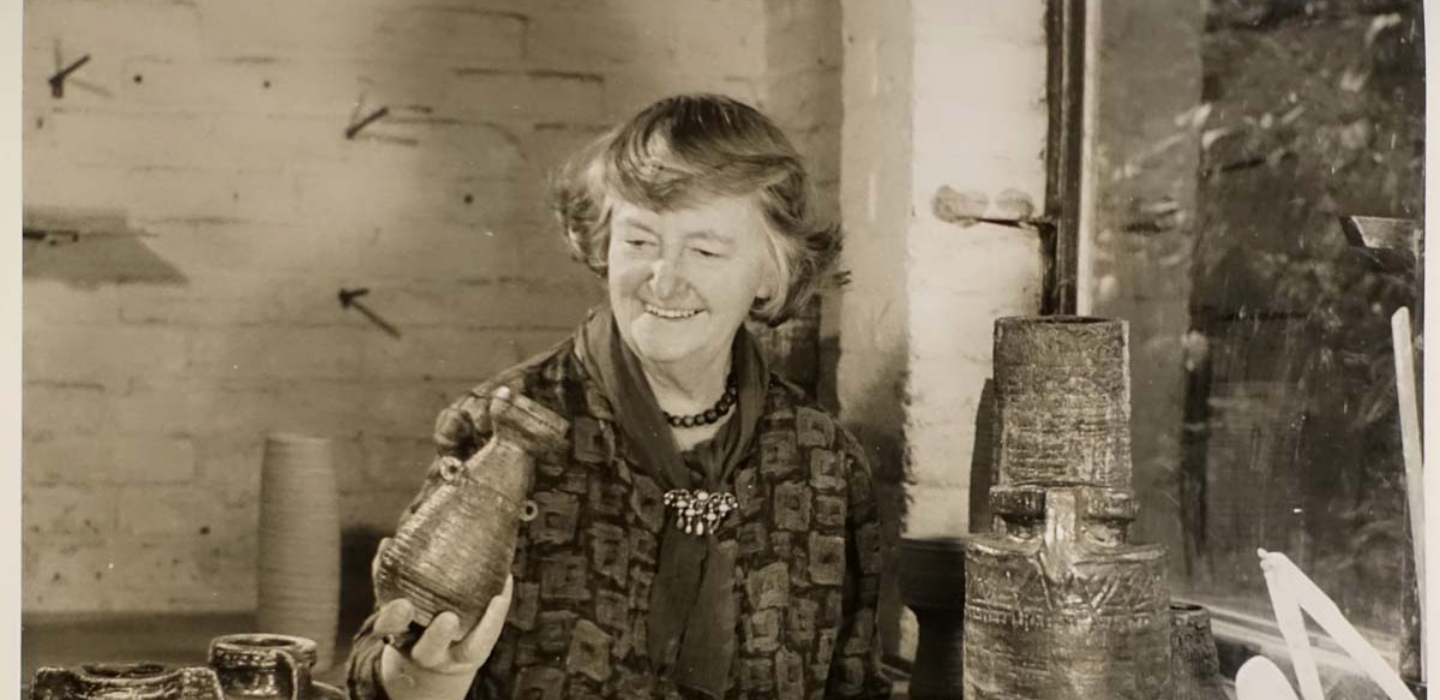
Denise Wren (1891–1979) was a pioneering potter and one of the first women studio potters in the UK.
Today her work is held in collections such as the V&A, the Crafts Study Centre in Farnham, York Art Gallery and Aberystwyth University. Kingston Museum holds a large archive of her work including her ceramics, designs, photographs, notebooks and letters.
Born Denise Tuckfield, Denise studied at Kingston School of Art between 1907-1912 and we have many pieces of her coursework in the collection. While a student, Denise became interested in pottery although at this time there were no specific pottery classes. Making pots was an industrial process carried out on a large scale, particularly in the Midlands. Some artisans painted readymade pots, but few craftworkers both designed and made ceramics. Archibald Knox, Denise’s teacher, sent her to Norbiton Potteries, which produced items like flowerpots and this is where she learned to throw pottery.
Knox Guild
Art Nouveau designer Archibald Knox was Design Master at Kingston School of Art. Knox’s unorthodox approach to teaching was condemned by the South Kensington Examination Board and he abruptly quit his teaching post in 1912. Devastated at the loss of their mentor, Wren and her fellow students founded the Knox Guild of Design and Craft (1912-1935) which championed Knox’s philosophy of art. The Guild, who were all women, sold their work from a showroom in Kingston Market Place and held annual displays in Kingston Museum Art Gallery, plus three exhibitions at the Whitechapel Gallery in East London during the 1920s.
During WWI, members of the Knox Guild were engaged in war work, but from 1919 they exhibited annually at Kingston Museum in the Art Gallery until 1935. The Guild also exhibited on 3 occasions at the Whitechapel Gallery in the East End of London.
The 1921 Knox Guild exhibition at the Whitechapel Art Gallery had a particularly wide reach.
"The London County Council…sent every day 250 school children to see it, while hundreds of the teachers came to see the practical demonstrations of art and craft work. During the month it was open over 54,000 people visited…."
(Surrey Comet 1921)
Oxshott Pottery
In 1920 Wren and her husband Henry purchased some land at Oxshott, Surrey, upon which they built their own home to Denise’s design. It was planned as a live/work space where they could produce pottery.
“The press usually assumed that Henry Wren was the potter while Denise Wren was his assistant”
Denise’s first kiln was imported from America, as there were no small scale kilns in the UK at that time. So Denise invented her own kilns and sold the plans for them by mail to amateur potters who wished to build their own.
Wren popularised pottery as a craft by giving classes and writing books together with her husband Henry and daughter Rosemary. Denise and Henry were especially interested in hand-built methods, in contrast to most potters of the time who preferred to make wheel thrown pots only. The Wrens wanted to make pottery accessible to all, so they taught methods like making coil pots and slab pots.
‘Messrs Oxshott Pottery’ was included in the British Empire Exhibition at Wembley in 1924-1925. During interviews, the press usually assumed that Henry Wren was the potter while Denise Wren was his assistant. In fact, she made the vast majority of the ceramics while Henry organised the displays.
Textile Designs
Denise had a second talent. From the late 1930s sales of pottery were slow and she turned to designing textiles to make ends meet. We have records of 150 designs for fabric that Denise produced between the 1930s and 1950s. She developed a contemporary style of lively prints, often using small plant and animal motifs in bright colours. She even designed patterns for Liberty dress fabric and for rugs.
"It is striking how few letters and archives associated with interwar women makers survive. The papers of…male artists, designers and architects, were carefully preserved by their wives and children. But …. Women can drop out of the already fragile history of the crafts with alarming ease."
Tanya Harrod The Crafts in Britain in the 20th c. (1999)
Kingston Museum has records of 150 designs for fabric that Wren produced between the 1930s and 1950s. She developed a contemporary style of lively, small-scale prints, with many plant and animal motifs in bright colours. She sold mainly to Manchester textile firms, though also designed a few patterns bought by Liberty.
Learn more about Denise Wren
Today, Denise Wren is increasingly recognised as an innovative studio potter who worked at the grassroots, disseminating her craft through teaching, exhibitions and publications. The public can view items from the Wren Collection at Kingston Museum.
Explore the Denise Wren Archive at Kingston Museum on Flickr.
